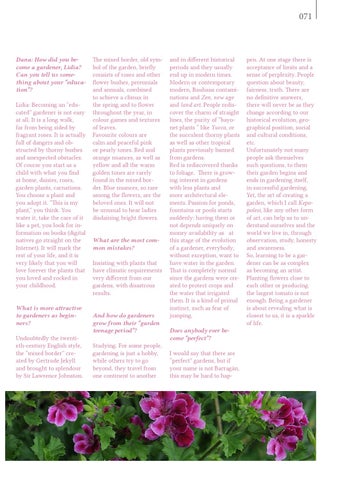071
Dana: How did you become a gardener, Lidia? Can you tell us something about your “education”? Lidia: Becoming an “educated” gardener is not easy at all. It is a long walk, far from being sided by fragrant roses. It is actually full of dangers and obstructed by thorny bushes and unexpected obstacles. Of course you start as a child with what you find at home, daisies, roses, garden plants, carnations. You choose a plant and you adopt it. “This is my plant,” you think. You water it, take the care of it like a pet, you look for information on books (digital natives go straight on the Internet). It will mark the rest of your life, and it is very likely that you will love forever the plants that you loved and rocked in your childhood. What is more attractive to gardeners as beginners? Undoubtedly the twentieth-century English style, the “mixed border” created by Gertrude Jekyll and brought to splendour by Sir Lawrence Johnston.
The mixed border, old symbol of the garden, briefly consists of roses and other flower bushes, perennials and annuals, combined to achieve a climax in the spring and to flower throughout the year, in colour games and textures of leaves. Favourite colours are calm and peaceful pink or pearly tones. Red and orange nuances, as well as yellow and all the warm golden tones are rarely found in the mixed border. Blue nuances, so rare among the flowers, are the beloved ones. It will not be unusual to hear ladies disdaining bright flowers. What are the most common mistakes? Insisting with plants that have climatic requirements very different from our gardens, with disastrous results. And how do gardeners grow from their “garden teenage period”? Studying. For some people, gardening is just a hobby, while others try to go beyond, they travel from one continent to another
and in different historical periods and they usually end up in modern times. Modern or contemporary modern, Bauhaus contaminations and Zen, new age and land art. People rediscover the charm of straight lines, the purity of “bayonet plants “ like Yucca, or the succulent thorny plants as well as other tropical plants previously banned from gardens. Red is rediscovered thanks to foliage. There is growing interest in gardens with less plants and more architectural elements. Passion for ponds, fountains or pools starts suddenly: having them or not depends uniquely on money availability as at this stage of the evolution of a gardener, everybody, without exception, want to have water in the garden. That is completely normal since the gardens were created to protect crops and the water that irrigated them. It is a kind of primal instinct, such as fear of jumping. Does anybody ever become “perfect”? I would say that there are “perfect” gardens, but if your name is not Barragàn, this may be hard to hap-
pen. At one stage there is acceptance of limits and a sense of perplexity. People question about beauty, fairness, truth. There are no definitive answers, there will never be as they change according to our historical evolution, geographical position, social and cultural conditions, etc. Unfortunately not many people ask themselves such questions, to them their garden begins and ends in gardening itself, in successful gardening. Yet, the art of creating a garden, which I call Kepopolesi, like any other form of art, can help us to understand ourselves and the world we live in, through observation, study, honesty and awareness. So, learning to be a gardener can be as complex as becoming an artist. Planting flowers close to each other or producing the largest tomato is not enough. Being a gardener is about revealing what is closest to us, it is a sparkle of life.
